So Much For The Weather
- Alan Emrich
- Sep 19, 2019
- 7 min read
The Motto of the Wise is: Be Prepared for Surprises
By Alan Emrich
There is nothing surprising about a change is the weather, is there? As in so many wargames, the weather die roll takes on almost mythical proportions as opposing gods of war await its augury. In Frank Chadwick's ETO, strategic weather patterns define the game's major Theater boundaries. The weather tables throughout the ETO series are based on the month, theater, and then for each a per-Game Turn die roll. The outcome of that die roll indicates the diktat of the map's Great Regulator – the weather. If you really want to see and feel the weather change, just play the Thunder in the East Operation Typhoon scenario!
Forecasting the Weather in the ETO Series
As we develop the entire ETO series, we have cast a weather eye on weather outcomes and effects. Below is a look at the full set of Weather tables and Locked turns (note that the South Atlantic and Indian Ocean's outcomes are "placeholders" until we sort that out for their use in Volume V: Victory at All Costs). You might want to study the strategic weather patterns (and note that die rolls of 5 and 6 are on their own columns each Month):

Surface & Atmospheric Conditions
Each type of weather has specific effects on surface and atmospheric conditions (which are generally clement or inclement). Since per-turn weather across Europe and the Mid-East is never 100% predictable, sagacious players plan for the most likely weather and prepare for opportunities presented by the slimmer chance of a change from that norm.
A Gallery of Weather, Timelock, and Theater Conditions
Take a moment to scroll through these ETO cards summarizing the various Theater-level effects. You will note their evolution as we "ETO-ize" the larger game series, including the introduction of a second set of Close Support Dice.
These Inclement Weather CS dice are similar to the Clement Weather dice you are used to, but these three dice have result symbols of: Shift, Shift, Blank, Blank, Airplane, and Airplane. They include no Heavy and no Red Bolt symbols as the Clement Weather CS dice do. Consequently, matters are less advantageous when applying Close Support rolls in inclement weather, but when permitted it could be worth the expected loss of performance and additional Air attrition from rolling the Inclement Weather CS dice.
Taking to the Air

All inclement weather is bad for the Axis and Allied Air Forces in Europe – period. During inclement weather only half of the Axis Air units mend during their Repair & Recovery Step (except during Mud where only Short Range Air units are so affected); this neatly simulates the overall loss of capability (measured as a decline in sortie rate) during inclement weather. It is important to note that inclement weather reduces air maintenance effectiveness for non-hindered Air Forces only; that is, Small nation, Soviet, and Italian Air Forces are not affected thus by inclement weather (its effects are a chronic condition for their Air Forces).
Worse for air operations, Overcast, Mud, Storms, and Snow weather (but notably not Extreme Cold) also prohibits flying Transport Missions except Air Supply. More importantly, you must use the inferior Inclement Weather CS dice if you seek Close Air Support during Overcast, Snow, or Extreme Cold weather. Again, the Gallery (ab0ve) allows for easy side-by-side weather effects comparisons.
So be aware of what your Air Forces can and cannot achieve when the weather is not Clear. Perhaps the sun is shining in another Theater? Your repairs might be halved in East Europe, but at least what is left can use their Strike Strengths in Crimea and the Caucasus. And there are plenty of other Missions that can be accomplished to your benefit or the opponent's deviltry other than Close Air Support -- bombing enemy Air Bases to suppress them is always useful, and a well-placed Logistics Bombing attack can protect a sector of your line from counterattack. See the article in this Player's Guide, We're on a Mission.
Pounding the Ground
Movement: While overruns are prohibited in all but Clear and Overcast weather, things really slow down in Mud where all overland movement is reduced to 1 hex per Movement Step (excluding Rail Movement). During Extreme Cold and Snow weather, all non-Mountain/non-Tundra hexes cost 2 Movement Points each, which slows things down considerably, though not as much as Mud does!
Combat: On "split" combat results when the weather is not Clear or Overcast, the inclement result is used (and during Snow that is the only inclement weather combat effect). Mud is harsh, handing the Defender a Swamp hex terrain benefit (in particular, halving attacking enemy Heavy units and receiving a defensive terrain shift in Battle). In Extreme Cold, Minor River hexsides are frozen (and ignored) while the first winter of the war inflicts Frostbite losses on most invading Ground units in these cold climates.
Winter in East Europe
During the entire first Season of each year (i.e., every turn in the months of January, February, and March) it is "Winter" in East Europe. This closes all of the Anchorage hexes showing an ice flow in the Baltic Sea and Gulf of Finland, but also opens up Ice Straits to use for movement and combat (of which there is only one in Thunder in the East at a remote-but-vital location near Leningrad).
Seeing Our Dentist About the Teeth in Frostbite
Much continuation playtesting and development has focused on Frostbite in the larger ETO scheme of things. While chilling at a virtual Frostbite Summit, the development team recalled that the effects of Frostbite on the Red Army during the Winter War (1939-40) against Finland were also notable. Likewise, if anyone invaded Sweden they would likely be in for the same cold reception.
In ETO development at the time of this writing, suffering the effects of Frostbite are more severe (and less subject to "being gamed") then when first designed for TITE. By making a large logistical effort (to send winter supplies instead of attack supplies), inoculation from Frostbite effects are possible. Whether resolved prophylactically by cardplay or as a result of brute survival, Frostbite effects only occur on an invader's first brutal Extreme Cold weather turns in that country.
[126.6.1] Frostbite: When enemy Ground units are in Finland, Sweden, or USSR during their first exposure to Extreme Cold weather there, they are subject to Frostbite. On the Summer Seasonal Interphase that follows, that Faction automatically flips its Frostbite Dateline card in play over to show its Winterized for [Nation] side as a reminder that this rules no longer applies to its forces there for the duration. In effect, they have earned their “Winter Scout Badge” and have their extreme cold-weather logistics sorted out.
[126.6.2] Winterized Forces: Certain units are “winterized” and immune to the effects of Frostbite. These include all Norwegian, Swedish, and Finnish units, plus all nations’ Partisan and Mountain Infantry units.
Each Faction also has a Winter Preparations card that, when played, in time, allows it to flip that nation’s Dateline card to show its Winterized for [Nation] side and inoculate its Ground and Air forces from the effects of Frostbite there.
[126.6.3] Effects of Frostbite: These are the effects of Frostbite during Extreme Cold weather turns in that nation:
When conducting their turn, affected Non-Winterized Ground forces apply the effects of Mud weather (126.4) instead of Extreme Cold weather. Affected Non-Winterized Air forces cannot use CS dice.
After performing their Supply Routine (441.1), their opponent makes a Frostbite Attrition roll of 1d3 (+1 in USSR and -1 in Sweden). The result is the number of RP’s worth (excluding any associated Fuel or Morale Point values) of their Non-Winterized Ground units in that nation and in EZOC’s (if possible) which the suffering player must select to reduce or eliminate (per 238.1). Medium Ground units forming a Small Corps Remnant unit (214.4) count as only 1/2 RP each.
Frostbite Example: The Axis forces are unprepared for the Extreme Cold in Russia. At the beginning of the Soviet turn, after performing the Axis Supply Routine, the Soviet player rolls 1d3 +1 (rolling a 4, which yields a d3 result of 2, +1 for this happening in the USSR, for a total of 3). The Axis player must select 3 RPs’ worth of Ground unit losses among their non-winterized units in EZOCs in the USSR.
The Axis player eliminates one full-strength Hungarian 2nd Line Infantry Corps (1 RP total and the loss of 1/2 Hungarian Morale Point), one German Garrison units (1/2 RP), and eliminates three reduced-strength German Corps with medals to their KG Remnant units (1/2 RP each) hoping to replace those KG units’ losses cheaply over time via Free Stuff (512.3).
About Frostbite in Combat
When the Germans invaded the Soviet Union, they famously prepared for a relatively short Blitzkrieg campaign. The pressed transport assets intended to bring forward materiel for a prolonged campaign (i.e., winter clothing, cold weather lubricants, extreme weather anti-freeze, etc.) were instead used to keep the assault troops well supplied with food, ammunition, and fuel.
Even as it became clear that the war in Russia would continue into the winter, the decision to keep pushing supplies for the offensive forward in hopes that one last push might finally take Moscow (and therefore “win the war”) is now the stuff of history.
Faced with one of the coldest winters in decades, tens of thousands of Axis soldiers froze to death or fell victim to severe frostbite during that terrible first winter from December 1941 to January 1942. When the campaign extended into its second winter, the Germans had learned their lesson and their troops were better prepared to deal with the extreme cold that Russia is famous for.
Pack some Warm, Dry Clothing
Weather is a vital consideration when playing a Campaign Game in particular, because longer and shorter runs of Clear weather have profound impact to the side on the strategic offensive, and cruel Mud weather, although often called neutral for having a similar effect on all sides, absolutely thwarts ground campaign momentum and therefore works to the advantage of the strategic defender (to lick wounds and prepare stronger defenses).

During invasions of Russia, the weather has historically favored the Russian cause; time and again their attackers suffered from the harsh weather which Russians have learned to endure. To nudge potential weather outcomes toward a more pro-Russian narrative, Thunder in the East provides a one-shot General Mud card (providing the Soviet player one weather reroll during a potential Mud turn). There is also an annually reusable General Winter card that can suddenly turn a Snow turn into one of Extreme Cold weather or vice-versa (for better or worse as this decision impacts Close Support availability, the freezing or not of Minor River hexsides and, during the first winter only, implementing of the Frostbite rule that turn).
As presented here, the weather effects are easy enough to grasp with impactful gameplay results that turn. The Weather cards, particularly when placed in an eye-catching location at a jaunty angle somewhere in a central, unused area of the map so that they are "visually disruptive" and therefore highly noticeable, serve to remind players of the current weather condition in that theater and, on their backs, summarize that weather's effects.
May your dice and the weather never blow too cold.

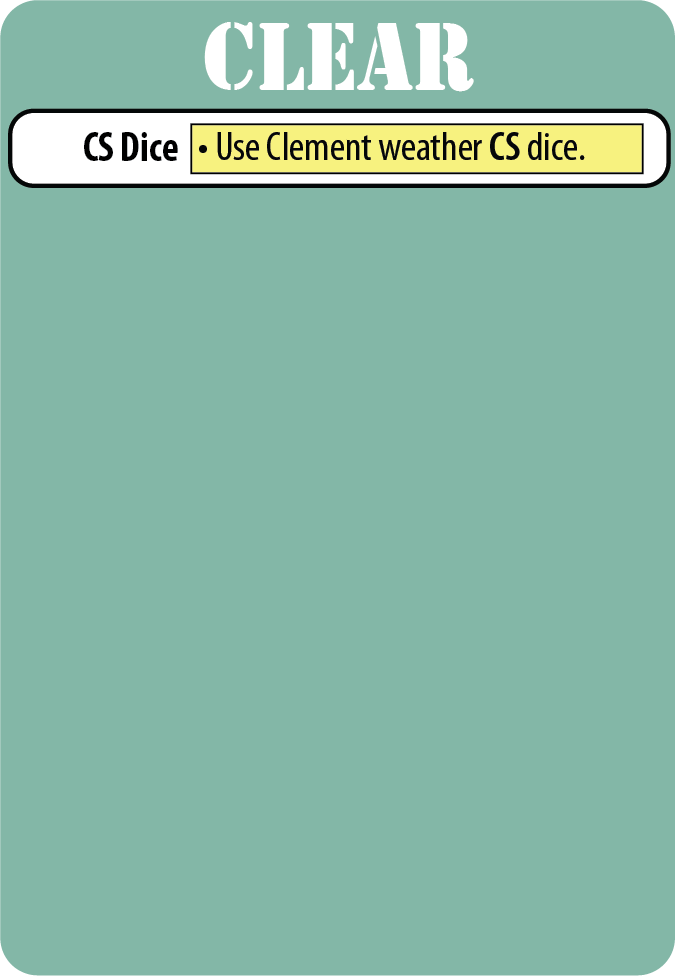

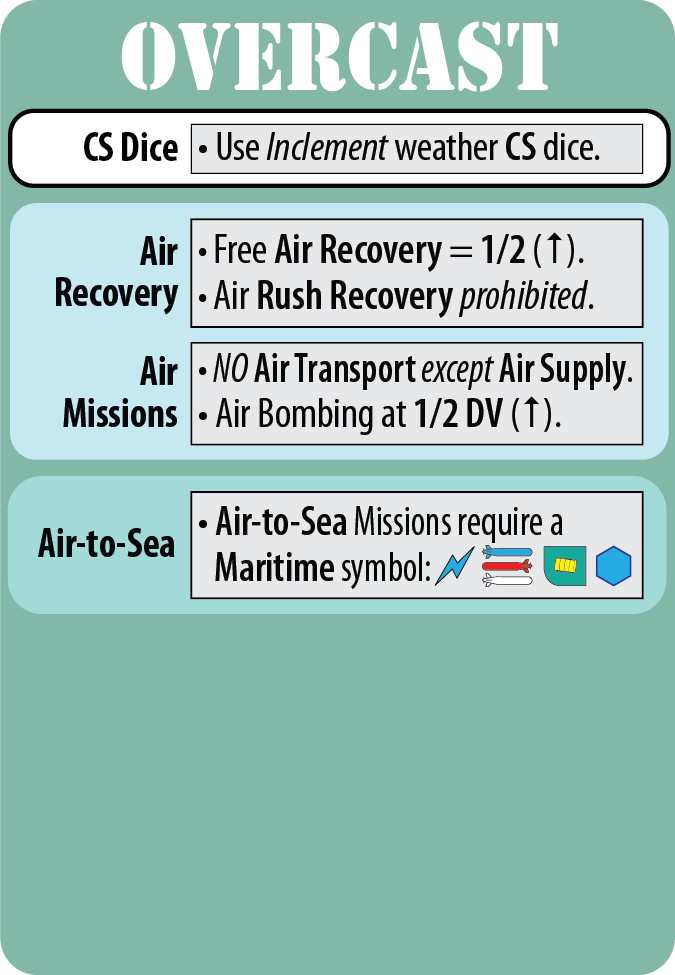

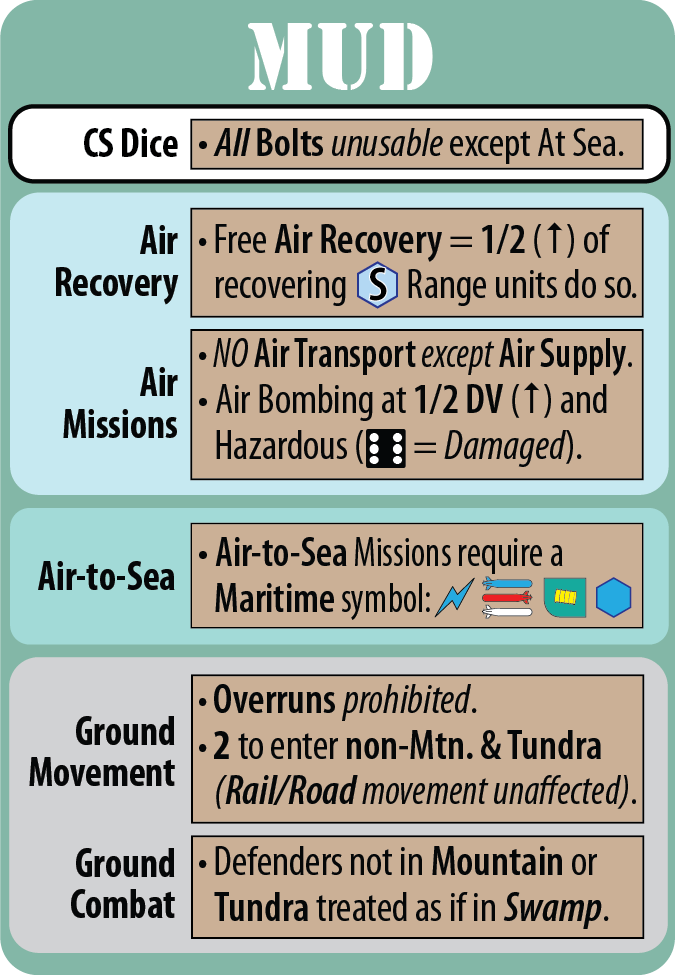

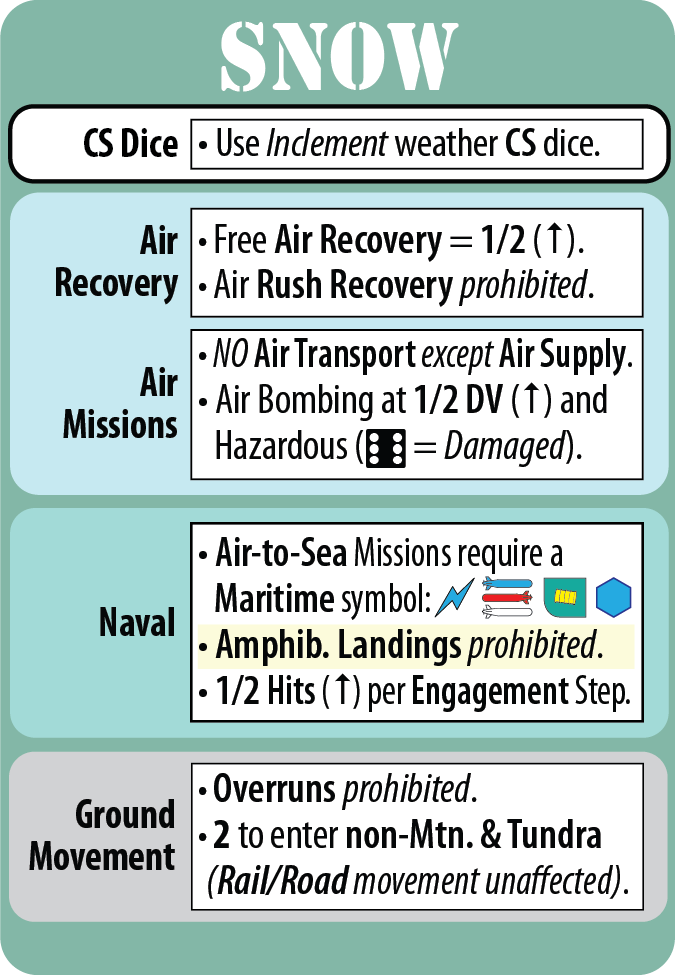

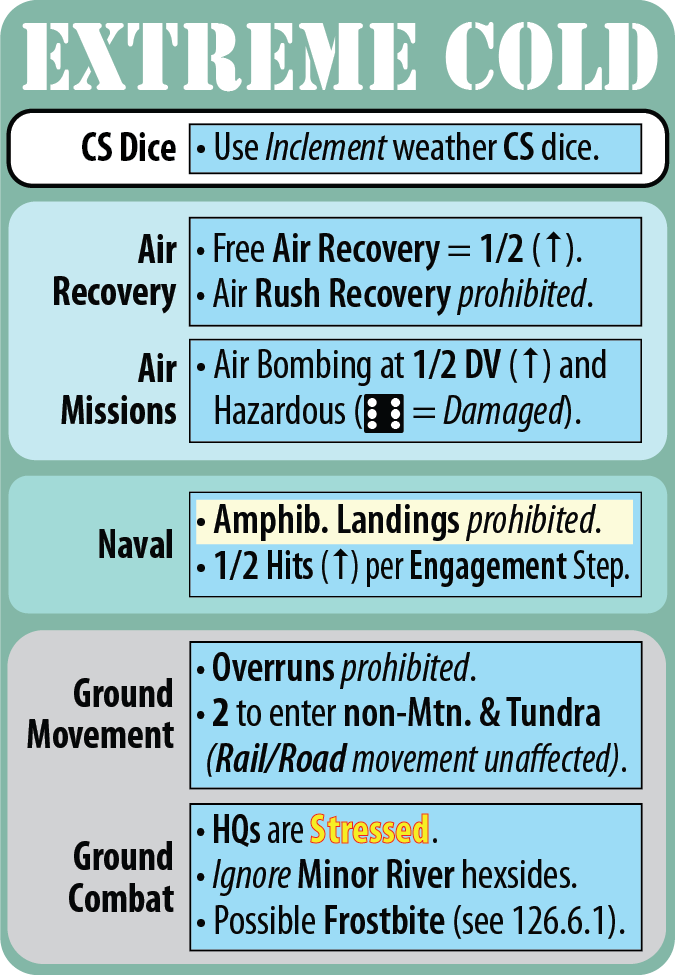

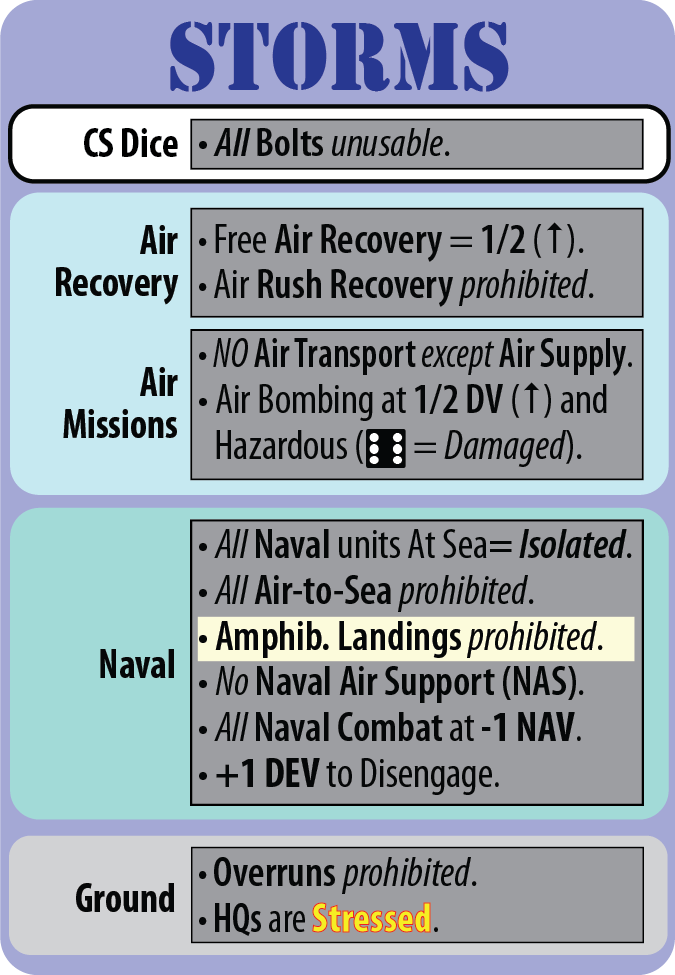

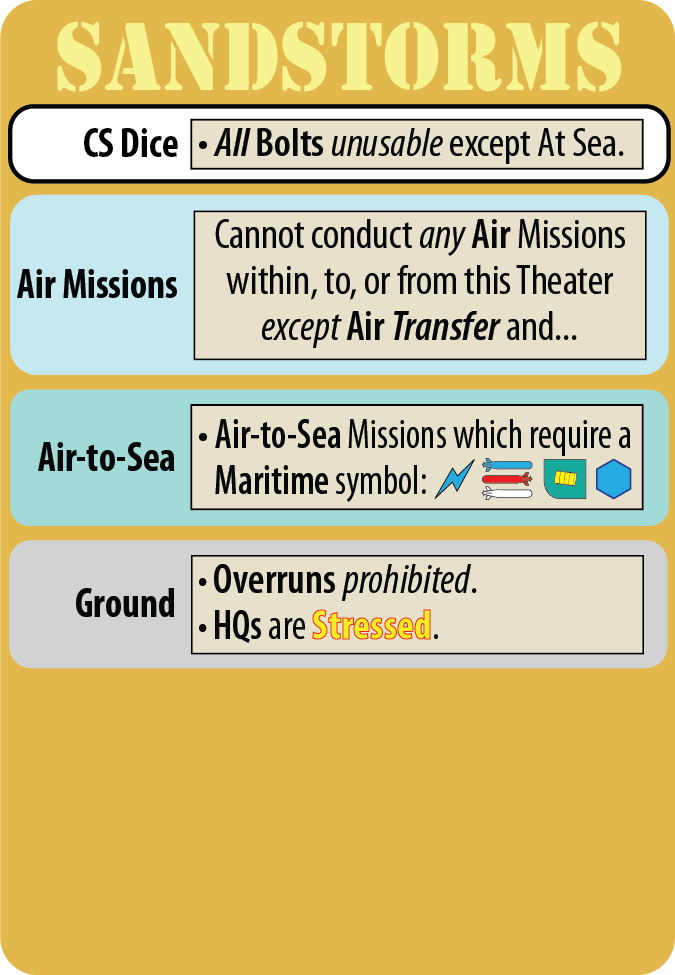

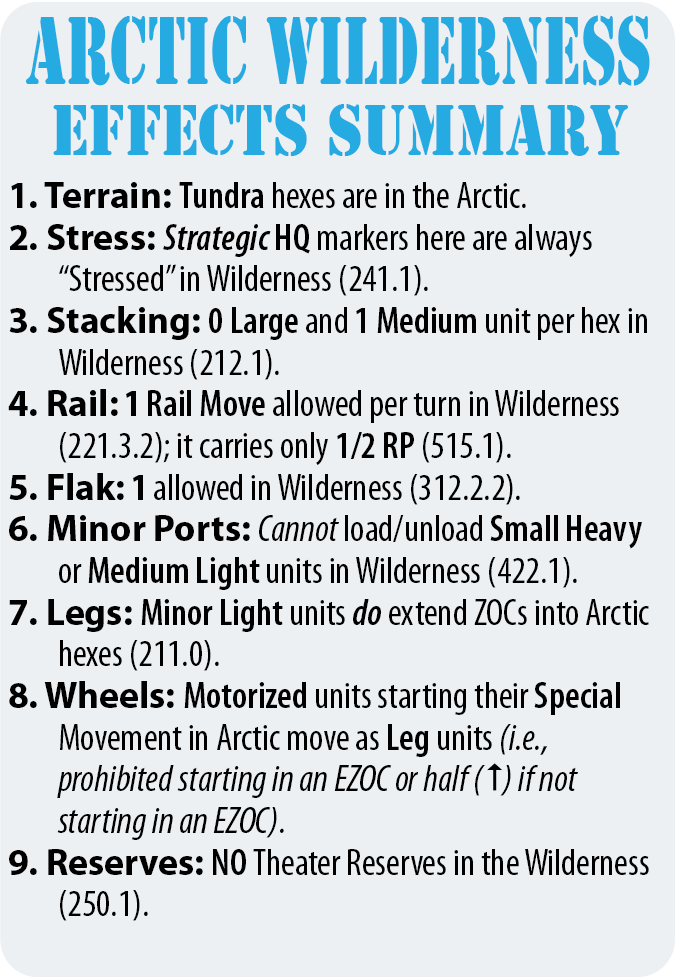



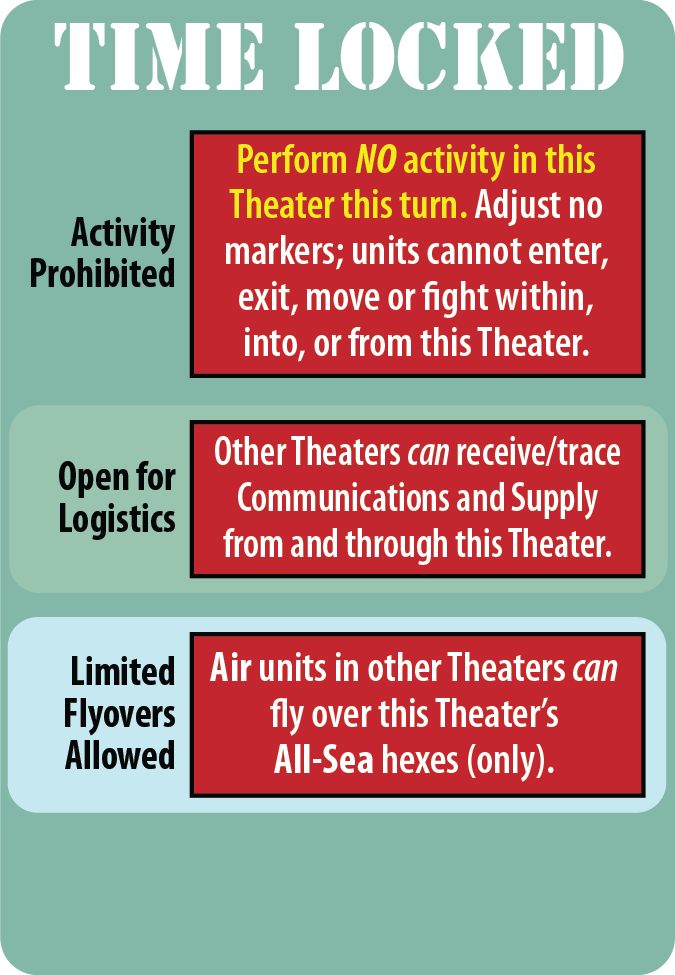

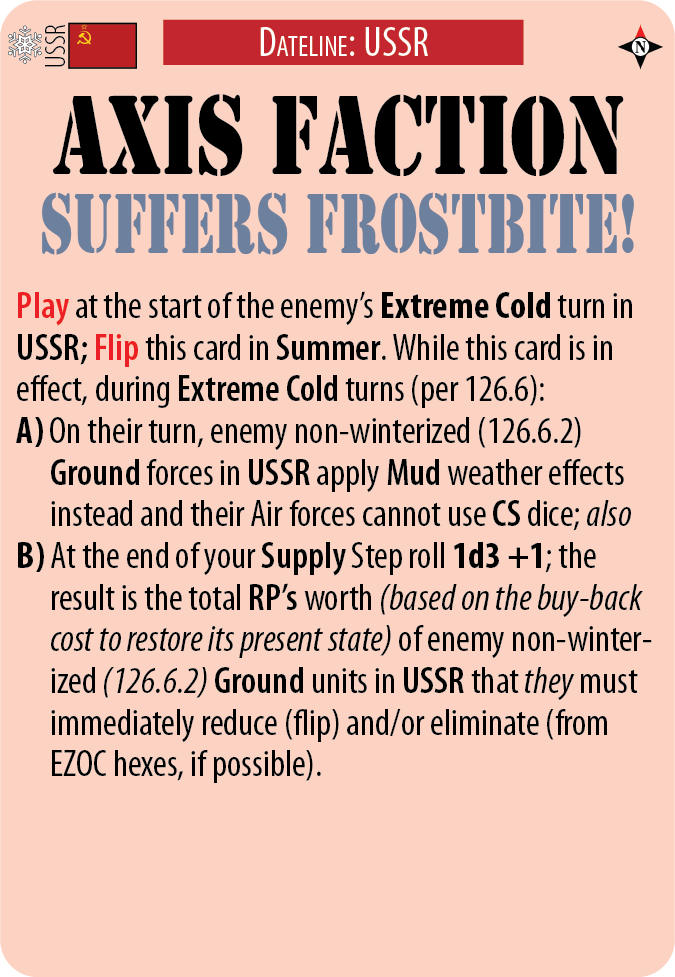

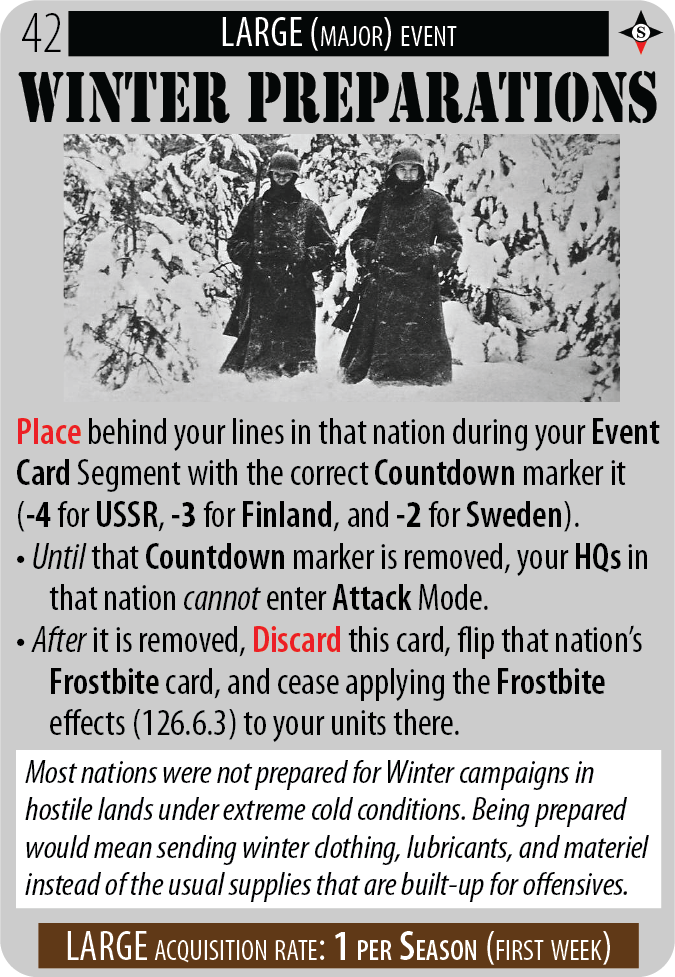






Cohen,
A player can only have one Large card in his hand after the Logistics Phase, so the Germans will want the awesome, Large Blitzkrieg card in hand if /when attacking the Soviet Union. Frostbite will occur during the first Dec through Feb after war begins vs that Nation (Russia, Finland or Sweden). Winter Preparations might best be drawn on Oct 1 just before.
A Heavy Panzer Corps can enjoy a White Bolt during Overcast (being Clement weather on the ground), but loses the benefit of the Heavy result. But with two White Bolts from Air, there is a decent shot at two shifts.
Big question from the ETO whole purpose.
Could such card be selected in let's say Winter '40 and thus be widely ready for the Winter later on? (Not sure obviously which other cards are there that may help, I mean the large OOB reorganization with 8 germans in the strategic reserve magically saves up to 8 PP / EP combined (if you tuck in there 8 one stepper corps).
About the CAS dice for Overcast I feel there should still be a need for 'Heavy' units, for bolts derivating from armoured units (enabled by Tank Aces or the like), so maybe the 'Heavy' component may remain but if overcast that nets a full shift only if at least 1 bolt…
I am pleased with the experiment of having limited CAS during Overcast, Snow and Extreme Cold. I usually have one Axis CAS mission, sometimes two, leaving out the Stukas, during these turns in '41.
I am anxious to see how Frostbite feels, but may go with Winter Preparations. It is Oct 1 in my game and I need to decide by Friday. I am not at the gates of Moscow, or at some critical point where I must press on, but, if I wait and "prepare", there will be a healing pause, with Shock Armies and Tank Corps arriving, and a lot of replacements. I am confident I can make progress in the winter, when there will be no m…